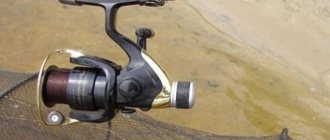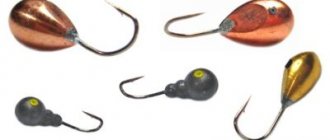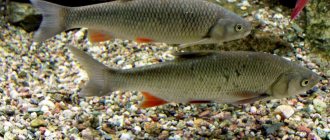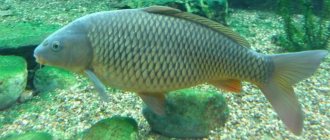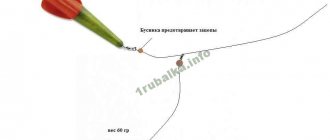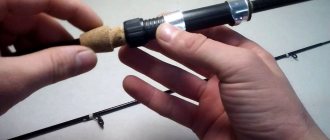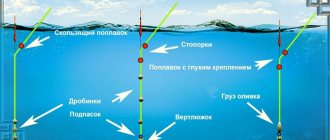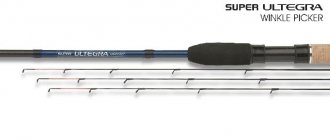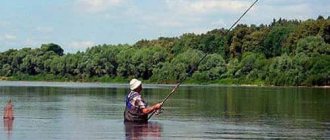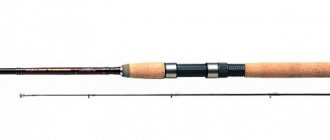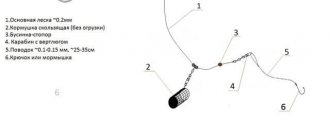If among modern float tackle there is a universal one, then it is definitely a Bolognese fishing rod.
It got its name from the name of the Italian province of Bologna, where one of the most famous factories for the production of fishing rods, Reglass, is located. This tackle has been familiar to our fishermen since the 1980s, when hitherto unprecedented fiberglass telescopic rods appeared on store shelves. They were, of course, not from Italy, but their design even then corresponded to the ideas about the Bolognese fishing rod.
Features of the tackle
Today, the Bolognese fishing rod is a tackle consisting of the following elements:
- multi-legged telescopic rod made of glass or carbon fiber, 5-8 m long, equipped with a reel seat;
- inertial or inertialess coil;
- main line;
- float (“blind” or sliding) with a set of clamps;
- set of weights;
- leash;
- hook;
The rod can consist of 4-8 elbows, each of which has one throughput ring installed. The last (upper) stage is equipped with 1-2 additional rings for a more even distribution of line tension.
The Bolognese fishing rod is a float tackle for long-distance casting, and allows for deep fishing at a distance of up to 30 m. It involves the use of large weighted floats, tightly attached to the fishing line, or with the ability to slide along it over a certain segment.
Rod
In Bolognese fishing, float rods are used, equipped with a reel seat and rings on long legs. As a rule, these are telescopic models, on the two upper legs of which the rings have a floating design, which removes the load from the top. As already mentioned, the length of such a fishing rod is about 7-8 meters, but simple float rods 4-5 meters long are also quite suitable for small rivers. Many people ask the question: “Why can’t you use a short rod on wide rivers?” In principle, you can fish with Bolognese tackle on any rod, but a short form will not allow you to sufficiently control the equipment, and the whole essence of Bolognese fishing will be lost.
On the fishing tackle market you can find a lot of suitable fishing rods. When choosing, you should pay attention to weight, rigidity, balance, and fastening of the rings. Do not forget that the rod works together with the reel, so when choosing, try to hold the tackle together.
Rod selection
The fishing rod for Bolognese tackle is selected based on the following positions:
- material;
- length;
- system;
- test(power);
Modern telescopic fishing rods are made either from composite materials, consisting of several layers of fabric impregnated with special resins, or from carbon fiber. The first option is more reliable in terms of strength, and the second is lightweight. When fishing on a flat, spacious place, you can use stands for fishing rods, and in this case, its weight will not affect the fisherman’s fatigue in any way. But if this is not possible, then you need to be an athlete to hold an 8-meter fiberglass fishing rod in your hands while fishing. Therefore, the best choice here would be a carbon fiber rod.
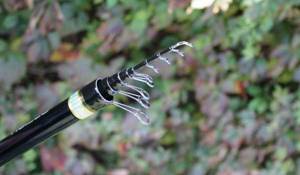
The length of the chosen fishing rod depends on the characteristics of the fishing location, the required casting distance, depth, and also on the preferences of the angler. Amateurs usually use 6-7-meter rods, which allow them to cast the tackle far and easily control it during the retrieve.
A fishing rod for Bolognese fishing, like all others, is divided according to its structure, which determines its ability to bend:
- fast or hard action - only the end of the rod bends;
- medium-hard tuning - only the upper third bends;
- medium action - the fishing rod begins to bend from the middle;
- parabolic (slow) action – when the rod bends along its entire length;
It is better to give preference to rods with a medium-hard or hard action. Such a fishing rod makes it possible to better manage the tackle during retrieving and make timely hooking without any delays.
As for the power of the rod , its value will also depend on the casting distance and depth. The most popular are fishing rods with test indicators of 4-20 g.
Attention should also be paid to the pass rings. Their inner surface must be perfectly smooth, without the slightest roughness, otherwise the fishing line will slow down due to friction when casting, and will also wear out quickly. Some branded rods are equipped with rings with porcelain liners inside.
The height of the legs of the guide rings also plays an important role, especially if there are drops of water on the rod. The higher the legs of the rings, the less likely the line will stick to the surface of the fishing rod.
How to choose a fishing rod
Rods for fishing with a Bolognese fishing rod differ in length, material of manufacture and design. For fishing with a Bolognese rod, telescopic and plug-in rods 4–9 m long, made of glass, carbon fiber or a combination of both – composite, are used.
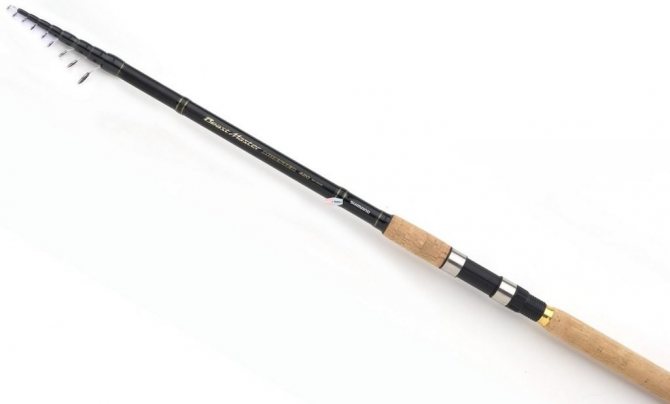
The Bolognese fishing rod is the most versatile method of float fishing
Depending on the length there are:
- short rods designed for fishing from a boat or in small bodies of water;
- rods 5–6 m long are the most versatile, they allow you to easily control the equipment, and at the same time are light enough for comfortable fishing;
- rods 7 or more meters long, which are used for fishing at great depths.
The material from which the rod blank is made determines its characteristics and cost:
- Fiberglass fishing rods are the most common due to their low price. Another advantage is their “indestructibility”. Otherwise, they are inferior to rods made from more modern materials;
- Carbon fiber rods (graphite, carbon) are light and elastic. They provide comfortable fishing, but require careful handling;
- composite – rods that use both glass and carbon fiber; They represent a compromise in both price and quality. The choice of a composite fishing rod is justified if the angler’s budget does not allow him to buy a carbon fiber rod.
In most cases, a Bolognese fishing rod is built on the basis of a telescopic blank. However, there are also plug-in Bolognese rods. They are similar to match fishing rods, but differ from them in their longer length and slower action. Such rods are used quite rarely. They are chosen either by athletes or aesthetes from Bolognese fishing.
Read more
Types of floats and their classification according to fishing conditions
Coil selection
The basic requirements for a reel for a Bolognese fishing rod are as follows:
- weight and size must correspond to the properties of the fishing rod;
- must accommodate at least 100 m of fishing line;
- the presence of a rear friction brake (if you plan to catch large fish);
- high gear ratio;
Shimano Nexave 1000, price 2200-2500 rubles.
Both inertial and inertialess reels are suitable for Bolognese fishing. If you have experience using the former, then you can use lightweight domestic models such as “Nevskaya” or “Nelma”. If there is no experience in handling such systems, it is better not to take risks and give preference to inertia-free structures.
Do not use a large spool. It will not only interfere, but will also upset the balance, which will affect both the angler’s fatigue and the quality of the retrieve. Depending on the length of the rod, its optimal size can vary between 1000-4000. For a fishing rod 7-8 m long, taking into account the average line thickness of 0.2 mm, a reel of size 3500 is ideal.
A rear drag is only required when fishing for large fish. If you come across just such a hook, there is always the opportunity to adjust it without twisting your arms.
The minimum gear ratio of a reel for a Bolognese fishing rod should start from 5.7:1.
All of the above requirements correspond to the parameters of a standard match reel. In other words, if you have experience in match fishing, it will also be useful in Bologna.
An article about choosing reels for float fishing.
Bolognese fishing rod rig
Teardrop floats should have a long keel made of carbon fiber or fiberglass, and cambers on the floats should secure them at the tip and in the middle.
1. Slippery floats are used in stagnant bodies of water with little current and great depth. Solid, lightweight floats are used in reservoirs with fast currents; they are convenient to control when holding. On small bodies of water, floats from 1.5 to 7.5 grams are used, on large bodies of water from 4 grams.
2. Antennas on the floats should be thin, up to 3 mm. If fishing occurs in cloudy weather or in the dark, then a yellow antenna is used, in the sun it is better to take a black one, and if glare waves appear during strong currents, then a red antenna is used.
3. The weight of the float should be such that a third of the float sticks out from under the water; this is necessary in order to notice even the weakest bite.
Lead olives are used for the equipment; it is the main load, the rest are feedstock and pellets. Shots are used when fishing in standing waters; they are spread along the line so that the float has less resistance when immersed or in the process of fishing for a trophy.
You can install a shot at the swivel, so the equipment will stay in the bottom, and the fish will be better fed. The swivel is used in the equipment so that the fishing line and leash do not get tangled when they are blown to the side during a strong current.
When catching small fish, select equipment from 0.1 to 0.2 mm, and a leash of 0.7 mm. The leash is chosen to be at least 60 centimeters, since thanks to it, a hold is made and the hook, in a strong current, rises a little and is directed forward; if the length of the leash is less, the hook will be near the sinker and the hold will not be effective.
To avoid an empty bite, the hook must match the equipment; if the hook and bait are small, then the bite will be weak or not at all. In Bolognese fishing, hooks number 14 to 18 are used.
Line selection
Salmo Specialist Match, price 180 rubles.
During installation, it is necessary to use exclusively monofilament fluorocarbon fishing line with a cross-sectional diameter of 0.14-0.22 mm in bright colors. For intensive sport fishing in clean places, fishing lines of 0.14-0.16 mm are most often used, for amateur fishing in places where there are snags or the bottom is overgrown with algae - 0.18-0.2 mm. In places with strong currents, it is best to use a “floating” fishing line in bright colors. In quiet waters, on the contrary, it is necessary for it to quickly sink to the bottom and be as transparent as possible.
The length of the main fishing line should not be less than 100 m. This amount is enough for casting, as well as for installing or repairing the tackle if it breaks.
An article on choosing fishing line.
Line and leash
From the experience of many anglers, the most suitable for fishing with a Bolognese rod is a sinking monofilament line. The choice of line thickness is based on what kind of fish the angler is going to catch and in what current.
When fishing for small fish or in small currents, a main line with a diameter of 0.14 mm and a leash with a diameter of 0.12 mm are suitable. For fishing in fast currents or for large trophies, you need a main line with a diameter of 0.16 mm and a leader with a diameter of 0.14 mm.
To prevent the leash from twisting, it is necessary to connect it to the main line using a swivel. The length of the leash should be 40-60 cm.
Float selection
The float plays a special role in Bolognese fishing.
Not only should it be minimally noticeable to fish and properly loaded, but it should also be clearly visible at a great distance in various conditions. For Bolognese fishing, sliding floats and floats with a stationary mount can be used. The latter are used in reservoirs where the depth is at least one meter less than the length of the fishing rod. Typically, floats of the following shapes are used:
- drop-shaped (with a body expanding downwards);
- fusiform (when the upper part is wider than the lower);
- flat (with a flat disc-shaped working surface);
Drop-shaped floats are universal. They are used both in standing reservoirs and on rivers with moderate currents. It is advisable to use spindle-shaped antennas with hollow antennas for various types of wiring. Flat floats with a disk-shaped working fluid located at a certain angle to the keel are perfectly controlled even in strong currents. Elongated floats can be used in calm water, but in currents or when playing with tackle, preference should be given to round bite indicators.
For good visibility, the float must be equipped with a thick and long antenna, otherwise you can recognize a bite at a distance of 30 m, and even in the current. The main difference between sliding floats for the Bologna rig is the long keel and antenna, as well as a through hole in the body through which the main line passes.
The weight of floats for a Bolognese fishing rod can range from 4 to 20 g. It is selected depending on the fishing conditions and the test of the rod. There are floats with variable dead weight. They are easy to recognize by their markings. For example, a float marked 8+4 has a weight of 8 g, but its design allows you to add another 4 g.
Bolognese floats are divided into two types:
- with single-point waggler fastening;
- with fastening at two points;
The first option, as a simpler and more reliable option, has gained great popularity when fishing in the current. The “Wagler” is fixed with the lower part of the keel to the main fishing line and stays vertically on the surface of the water solely due to the balance between the load and its upper part. In addition, such floats showed excellent aerodynamic properties when casting.
Techniques and tactics of fishing with Bolognese tackle
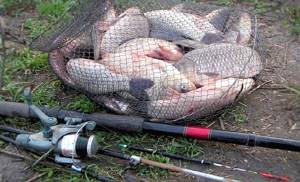
Let's consider two main fishing conditions:
- on the current
- in still water.
Fishing with a Bolognese fishing rod in current conditions requires knowledge of a certain technique for controlling the wiring of the equipment. Throwing bait or bait is done by calculating the strength of the current, so that its train coincides with the route of the equipment. Consequently, complementary food is thrown a little higher upstream, where the wiring itself will be carried out, respectively, further downstream. Having thrown the equipment to the required place, the fisherman, by pulling the fishing line, adjusts the course of the float in the correct vector of its movement.
At points where bites are noticed, it is recommended to make small stops of the equipment by holding the float with the tension of the fishing line from the rod. There are also frequent bites at the end of the wiring route, when the equipment begins to move against the flow. The fisherman must be on alert precisely at such moments of his actions. Fishing is labor-intensive, as almost every couple of minutes the gear needs to be re-cast.
Fishing in a still body of water is technically much simpler. A certain promising point is fed and the fishing depth is selected. The tackle is precisely directed to the feeding site and when the float antenna is immersed under the water, a sharp hook is made.
Important! When the wind and waves on a pond become stronger, the gear needs to be re-equipped with a float and a weight. The stronger the wave, the heavier the float is used.
Loading tackle
Properly loaded float
In Bolognese gear, the float can be loaded with either a single load or a combined one. It all depends on the fishing conditions. For standing water, the following combination is most often used: 60% of the bulk of the load in the form of large pellets is fixed near the float, and the remaining 40% (small pellets) are distributed into 2 groups at a distance of 15-20 cm.
In reservoirs with very slow flows, it is advisable to use a chain of pellets located at a distance of 10-15 cm from each other (in descending weight) from the float to the sub-grass. In moderate currents, the pellets are placed next to each other at a distance of about 70 cm up from the leash. If the flow speed is high, then the best option would be a drop-shaped sliding load, fixed at the bottom with small pellets.
Properly loaded tackle should leave only the float antenna on the surface. Therefore, to achieve the optimal balance, it is necessary to prepare the equipment at home and check it in advance.
Correct shipment of Bolognese floats with a set of pellets
There are no strict rules for loading a bite indicator, since this is influenced by many factors - depth, current, fish being hunted and even the presence of small fish in the upper water horizon. The main thing is to avoid either overloading, since it will be much more difficult to control the equipment, or underloading - the float will float up sharply.
Fishing, a homemade device for loading Bolognese floats is quite simple. The main thing is to choose a material with neutral buoyancy for its manufacture. The advantage of this design is that it allows you to select sinkers without attaching them to the line, using small utensils.
The role of loading is quite significant, since it performs the following functions:
- reduces excessive buoyancy;
- supports the nozzle used;
- transmits bite data;
- keeps the line in tension;
- allows you to cast.
On average, from five to ten pellets are used; anglers select the number of them depending on the correct combination with the float. In this case, the total weight of the load must match the test characteristics of the bite indicator. So, if the load capacity is 4 grams, the total weight of the pellets should be equal to this value.
The set of concepts - fishing, correct shipment of Bolognese floats, the process of shipment - consists in the arrangement of weights in the form of a pyramid, the top of which lies at the hook. That is, the largest grain is located at the top, and a feeder is mounted at the bottom.
Thanks to the auxiliary shed, excellent balancing of the equipment is achieved, especially since it is very functional. They are used for fishing in calm waters and at decent currents. The sensitivity of the gear increases significantly, and fish are more willing to take bait on fishing rods equipped with a hook.
Hook
For any fishing, it is better to have a whole set of hooks, or better yet ready-made leashes, in order to be able to promptly replace them due to changing fishing conditions or if the gear breaks. The size of the hook depends on the fish you intend to catch, as well as the type of bait. If you use bloodworms, maggots or small grains, hooks size No. 14-No. 18 are suitable. For worms, peas, and corn, it is better to use hooks No. 8-No. 12.
Sliding equipment
We have already written about blind equipment here.
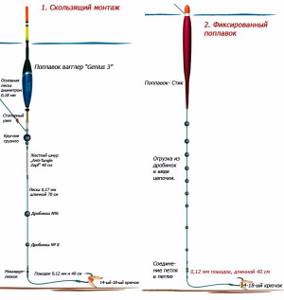
Installation of any sliding float tackle, including Bolognese, includes the following steps:
- The reel is attached to the rod body via a reel seat.
- The end of the main line from the end of the fishing rod is passed through all the rings and fixed on the spool of the reel.
- A fishing line is wound onto the reel (minimum 100 m).
- The line is cut with a margin of about 2 m.
- A rubber or silicone upper stopper of the sliding equipment is placed on the free end of the fishing line and pulled to a distance of 1 m from the end (when using an inertial reel, it is better to tie a stopper knot).
- A sliding bead is placed on the end of the fishing line and pulled to the upper stopper.
- Next, a float is attached to the fishing line (at one or two points).
- After this, the sliding bead is put on again.
- The bead on the back side of the float at a distance of 0.7-0.8 m from the upper stopper is fixed with a lower stopper and a set of weights (for still water or for current).
- The end of the fishing line is formed into a loop for tying a leash.
- A leash is attached to the fishing line through a swivel.
Leash attachment
The purpose of the leash is to protect the tackle from breaking. Typically, leaders are used that are 0.02 mm thinner than the main line. In Bolognese fishing, leashes 20–70 cm long are used.
The length of the leash is determined experimentally. If there are a lot of empty bites, the leash is lengthened. If the fish swallows the bait deeply, shorten it. With the correct leash length, the fish should be caught by the lip.
The leash can be attached to the main line either using a swivel or loop to loop. The first method is preferable because when reeling in the rig, the nozzle often acts like a propeller and spins the line. In this case, the smaller the swivel used, the better.
Read more
Features of match fishing
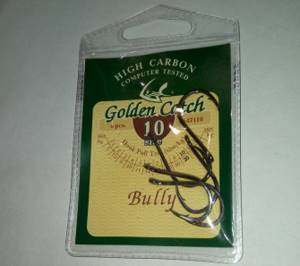
Fishing hooks Golden Catch Bully No. 10
Bait and feeding tactics
For Bolognese fishing, any bait used for fishing in the current is suitable, however, when choosing it, you should take into account the type of fish, as well as the mandatory content of adhesives in the feed.
You can prepare the bait yourself, but it is better to purchase a ready-made mixture at specialized sales points. Its quantity for one fishing trip should be at least 3-4 kg. For greater density, about 2 kg of clay can be added to its composition. It is better to check bait soaked and diluted with clay by throwing it near the shore. If the ball of the mixture, having sunk to the bottom, does not crumble for a long time, it means that the bait is too dense. It won't really attract fish. The bait should crumble well at the bottom, creating a kind of cloud of mixture particles.
During the current, the entire water strip along which the wiring will be carried out is fed.
For deep places, when starting complementary feeding, you need to use half of the entire mixture. The rest of the bait is delivered to the fishing site in equal portions throughout the fishing trip.
Feeding the area is done either manually or using a slingshot with a special bowl.
- When casting by hand, balls the size of an orange are rolled out of the soaked bait, after which they are thrown into the desired place.
- If the distance is too great, it is better to use a slingshot. With this type of feeding, the finished compressed mixture is placed in the bowl of a slingshot and shot in a certain direction.
